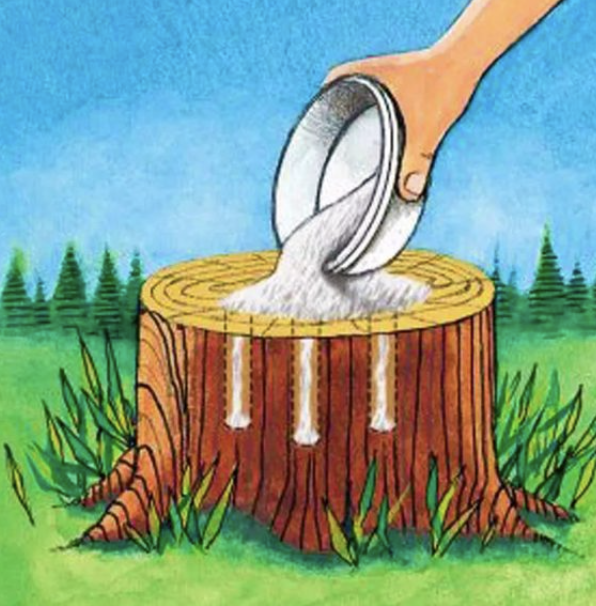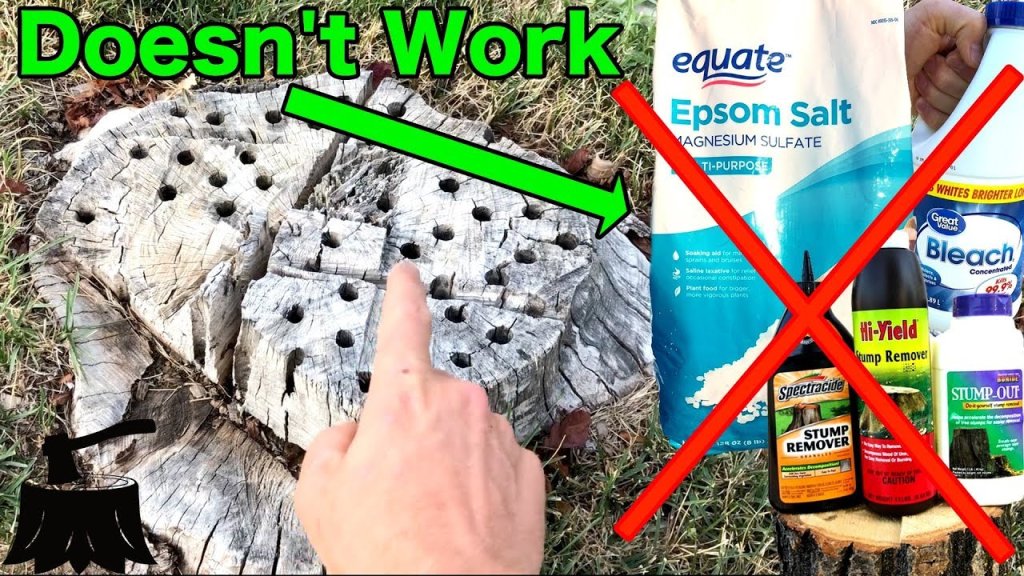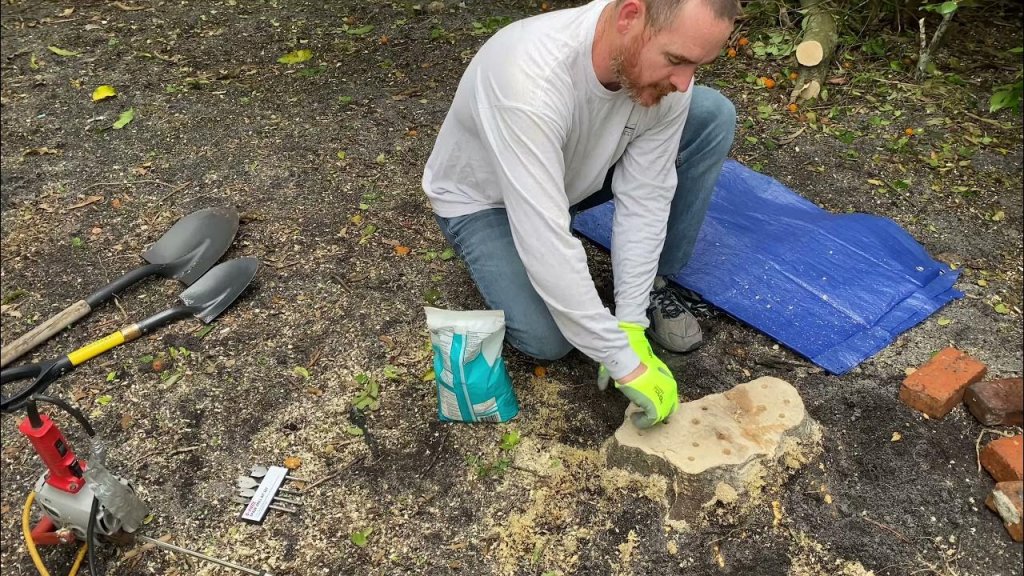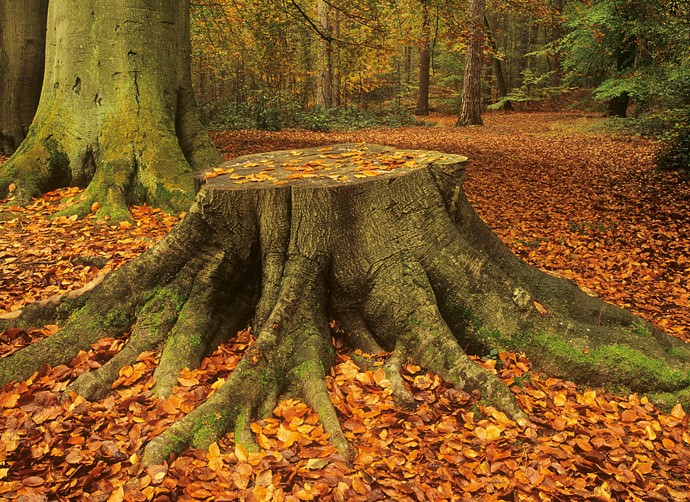Removing a tree stump can be a challenging task, but with the use of Epsom salt, it can become a cost-effective and natural solution.
Epsom salts have been known for their various uses, including conditioning the soil in gardens and acting as a weed killer.
In this article, we will explore the benefits of using Epsom salts for tree stump removal and discuss DIY methods for safely and effectively getting rid of unwanted stumps.
Additionally, we will cover important safety precautions and environmental considerations when using Epsom salt for stump removal.
Key Takeaways
- Epsom salts can effectively kill and rot tree stumps, including the roots that may have infiltrated sewer lines.
- A homemade Epsom salts root killing recipe involves mixing 1 gallon of Epsom salts with 2 gallons of water and applying the solution to the stump and exposed roots.
- Drilling holes in the stump and covering it with a tarp can expedite the stump removal process when using Epsom salt.
- Safety precautions should be taken when using Epsom salt for stump removal to protect sewer lines and minimize environmental impact.
- Disposal of the stump and roots should be done responsibly to minimize environmental impact and ensure proper waste management.
Using Epsom Salts to Remove Tree Stumps

Benefits of Epsom Salts
Epsom salts, known chemically as magnesium sulfate, are a versatile household item with a range of uses beyond personal care. In the context of gardening, Epsom salts can condition the soil and, in higher concentrations, serve as an effective stump and weed killer.
When it comes to removing tree stumps, Epsom salts offer a less harsh alternative to commercial root killing chemicals. They can help to kill and rot the tree stump, including any problematic roots that may threaten your plumbing.
Epsom salts’ ability to break down stubborn tree stumps while being gentle on the surrounding environment makes it a preferred choice for many gardeners.
Here’s a simple list of benefits Epsom salts provide in stump removal:
- Acts as a natural root killer without harsh chemicals
- Conditions the soil around the stump, potentially benefiting nearby plants
- Helps prevent regrowth of the stump
- Is cost-effective and readily available in stores like Home Depot and Lowes
Homemade Epsom Salts Root Killing Recipe
Creating a homemade Epsom salts root killing solution is a cost-effective and environmentally friendly way to address unwanted tree stumps. The recipe is simple, requiring only a few common household items.
To prepare the mixture, you will need:
- 1 gallon of Epsom salts
- 2 gallons of water
- A 5-gallon bucket
- A tarp to cover the stump
Mix the Epsom salts with the water in the bucket until fully dissolved. Pour the solution generously over the stump, ensuring it soaks into the roots. Cover the stump with the tarp to retain moisture and prevent dilution from rain. This process should be repeated weekly until the stump shows signs of decay and no longer poses a problem.
This method not only helps in stump removal but also prevents the roots from growing further and potentially interfering with underground utilities. While commercial root killing chemicals are available, they often come at a higher cost and with more environmental concerns. The Epsom salt solution offers a gentler alternative, with the added benefit of being readily available and easy to use.
Using Epsom Salts for Stump Removal
Epsom salt, a common household item, is not just for footbaths; it’s also an effective solution for removing tree stumps. The application of Epsom salts can kill and decay a tree stump, including its roots, which may pose a threat to underground water pipes and septic systems.
To use Epsom salts for stump removal, create a mixture of 1 gallon of water with 4 pounds of Epsom salts. Stir the solution well before applying it to the stump and any exposed roots. Cover the treated area with a heavy plastic sheet to accelerate the process.
For best results, follow these steps:
- Drill holes in the top of the stump to allow the Epsom salt solution to penetrate more deeply.
- Pour the prepared Epsom salt solution over the stump and into the holes.
- Cover the stump with a plastic sheet and secure the edges to prevent displacement.
- Check the stump weekly for signs of decay and reapply the solution as needed until the stump is fully decomposed.
Commercial Root Killing Chemicals
While Epsom salts provide a gentle and cost-effective method for stump removal, commercial root killing chemicals offer a more potent alternative. Products like RootX, containing Dichlobenil, are designed to tackle invasive tree roots in sewer systems without damaging septic systems. These commercial options, although reliable, tend to be more expensive than DIY solutions.
When considering commercial chemicals, it’s important to weigh the cost against the convenience and strength they provide. Homemade mixtures may require more frequent applications compared to their commercial counterparts.
For those facing regular blockages in their sewer systems due to tree roots, commercial root killers can be a practical solution. Here’s a simple comparison of common chemicals used:
- Rock Salt: Affordable, flush a handful down the toilet bi-weekly.
- Copper Sulfate or Sodium Chloride: More powerful, flush half a pound, repeated four times.
- RootX: Convenient, contains safe Dichlobenil, less frequent application needed.
Always use commercial chemicals in accordance with the manufacturer’s instructions to ensure safety and effectiveness.
DIY Tree Stump Removal Methods

Epsom Salts vs. Commercial Products
When considering the removal of tree stumps, homeowners often weigh the benefits of using Epsom salts against commercial stump removal products. Epsom salts, a common household item, offer a natural and cost-effective solution for conditioning soil and eliminating unwanted tree stumps.
Commercial products, on the other hand, are specifically formulated for stump removal and may act more quickly. However, they often contain chemicals that can be harsh on the environment and may pose risks if not used properly.
- Epsom Salts: Natural, cost-effective, may improve soil health.
- Commercial Products: Fast-acting, chemically formulated, potential environmental risks.
While Epsom salts require patience and repeated applications, they provide a gentler alternative that can benefit the soil in the long run. In contrast, commercial products deliver swift results but at the cost of introducing potent chemicals into your yard.
Epsom Salt Solution Application
Once you have your homemade Epsom salts root killing solution ready, the application process is straightforward but requires patience and precision. Ensure that the solution is thoroughly mixed before applying to achieve the best results.
- Mix 1 gallon of Epsom salts with 2 gallons of water in a 5-gallon bucket.
- Stir the solution until the salts are completely dissolved.
The effectiveness of the Epsom salt solution is contingent on its concentration and the method of application. It is crucial to apply the solution directly to the stump to ensure that it reaches the root system.
After preparing the solution, pour it over the stump, making sure to cover the entire surface area. For larger stumps, you may need to repeat the application several times, allowing the solution to penetrate deeply. The Epsom salt will gradually dehydrate the stump and roots, making them easier to remove.
Drilling Holes in Stump
Drilling holes into the stump is a critical step in the stump removal process using Epsom salts. The holes allow for deeper penetration of the Epsom salt solution, ensuring that it reaches the root system effectively. This method enhances the decomposition of the stump, making it porous and easier to remove or burn.
For optimal results, follow these steps:
- Use a large drill bit to create holes across the surface of the stump.
- Drill holes around the sides of the stump, angling them down to intersect with the bottom of the top holes.
- The depth of the holes should be about 8-12 inches, depending on the size of the stump.
After drilling, it’s advisable to apply hot water to the stump before introducing the Epsom salt solution. This helps in accelerating the decomposition process. You can expect to see results within a few weeks to a few months, depending on the size and density of the stump.
Covering Stump with Tarp
After applying the Epsom salt solution to the stump, it’s crucial to cover the stump and exposed roots with a heavy plastic sheet or tarp. This step is essential as it helps to trap moisture, which accelerates the rotting process of the stump. Weigh down the edges of the tarp to ensure it stays in place and check weekly for progress. The tarp also serves to protect the stump from external elements that might slow down the decomposition.
To enhance the effectiveness of this method, consider drilling additional holes in the stump before covering it. This allows the Epsom salt solution to penetrate deeper and ensures a more thorough absorption.
Remember to repeat the application of the Epsom salt solution and the covering process as often as necessary until the stump is sufficiently decomposed for removal. Below is a simple guide to the steps involved:
- Pour the Epsom salt solution over the stump and exposed roots.
- Cover with a heavy plastic sheet or tarp.
- Weigh down the edges to secure the covering.
- Check weekly and reapply the solution as needed.
Tree Stump Removal Safety

Safety Precautions
Safety is paramount when removing tree stumps, especially when using chemicals like Epsom salt. It’s essential to wear appropriate safety gear to prevent accidents and protect your health. At a minimum, gloves should be worn to avoid skin irritation from the Epsom salt. If you’re handling large quantities, safety goggles are also recommended to protect your eyes from potential splashes.
When applying Epsom salt or any stump removal chemicals, be mindful of the surrounding area. These substances can be toxic, so it’s crucial to keep children and pets at a safe distance to prevent ingestion or contact.
Additionally, consider the following safety tips:
- Always read and follow the instructions on the product label.
- Do not apply stump removal chemicals on windy days to avoid dispersal.
- Ensure the area is well-ventilated if you’re working in a confined space.
- After application, properly seal and store any leftover chemicals out of reach of children and animals.
Environmental Impact
When considering the environmental impact of tree stump removal, it’s crucial to assess the methods and materials used. Epsom salt, while being a natural compound, can alter soil composition and potentially affect nearby plant life. Excessive use may lead to soil desiccation, making it inhospitable for future planting.
The use of Epsom salt for stump removal is often touted as an eco-friendly alternative to chemical stump removers. However, it’s important to use it judiciously to minimize any negative effects on the environment.
Here are some considerations to keep in mind:
- Epsom salt can increase magnesium levels in the soil, which might be beneficial in some cases but detrimental in others.
- The impact on surrounding vegetation should be evaluated, as high concentrations of salts can harm plant roots.
- It’s essential to follow proper application techniques to ensure that the Epsom salt is targeted only at the stump and does not spread to other areas.
Protecting Sewer Lines
When removing tree stumps, it’s crucial to consider the proximity of sewer lines. Tree roots are naturally drawn to the nutrients in sewage and can infiltrate even the smallest cracks in pipes, leading to blockages or damage. Alice Gilbert, a home improvement expert, emphasises the risks associated with tree roots and sewer lines.
To prevent such issues, a homemade root killer can be an effective solution. Here’s a simple recipe:
- 1 gallon of water
- 4 pounds of Epsom salt
Mix the ingredients and apply directly to the problematic area. For ongoing maintenance, apply this solution periodically to discourage root growth in your sewer lines.
While professional-grade chemicals offer potent root control, they should be handled with care. For safety and effectiveness, consider consulting a professional before using any chemical treatments near your sewer lines.
Remember, proactive measures can save you from costly repairs and ensure the integrity of your sewer system while you address tree stump removal.
Disposal of Stump and Roots
Once the stump and roots have been effectively treated and are dead, it’s time to consider their removal and disposal. Ensure that all pieces of the stump and roots are completely dead before attempting removal to prevent any regrowth.
- Break down the stump into smaller, manageable pieces using a chainsaw or an axe.
- For larger stumps, renting a stump grinder may be the most efficient method.
- Dispose of the stump material by following local regulations, which may include taking it to a green waste facility or having it collected by a yard waste service.
Remember, the decomposition process can take several weeks to months, so patience is key. Regularly check the stump for progress and continue the Epsom salt treatment as needed until the stump can be easily fragmented for removal.
After the stump is removed, fill the hole with soil and consider planting grass or other vegetation to restore the appearance of your landscape.
Conclusion
In conclusion, using Epsom salt to remove a tree stump is an effective and environmentally friendly method.
The process involves creating a solution of Epsom salts and water, pouring it over the tree stump and roots, and covering it with a tarp.
This natural root killer gradually decomposes the stump and roots, eliminating the need for harsh chemicals.
Additionally, Epsom salt can be used to condition soil and act as a weed killer, making it a versatile and cost-effective solution for maintaining your garden and yard.
Whether you choose to use homemade Epsom salt root killing recipes or commercial root killing chemicals, the result is a hassle-free way to get rid of unwanted tree stumps and roots.
Say goodbye to unsightly stumps and hello to a beautifully landscaped yard with the power of Epsom salt.
Frequently Asked Questions
How long does it take for Epsom salts to remove a tree stump?
The time it takes for Epsom salts to remove a tree stump can vary depending on the size and condition of the stump. Typically, it may take several weeks to several months for the stump to completely rot and be removed.
Is it safe to use Epsom salts for tree stump removal?
When used as directed, Epsom salts are generally safe for tree stump removal. However, it’s important to follow safety precautions and environmental guidelines when applying Epsom salts to prevent harm to surrounding plants and wildlife.
Are there any environmental concerns with using Epsom salts for stump removal?
While Epsom salts are generally considered safe for the environment, excessive use or improper disposal of Epsom salt solutions can impact soil and water quality. It’s important to use Epsom salts responsibly and to dispose of leftover solutions properly.
What are the benefits of using Epsom salts for tree stump removal?
Using Epsom salts for tree stump removal offers a natural and cost-effective alternative to commercial root killing chemicals. It can also condition the soil and reduce the risk of regrowth from the stump and roots.
How should I dispose of a tree stump treated with Epsom salts?
After the tree stump has completely rotted and is removed, the remaining wood and roots can be disposed of through composting, recycling, or local waste management services. It’s important to follow local regulations for stump disposal.

